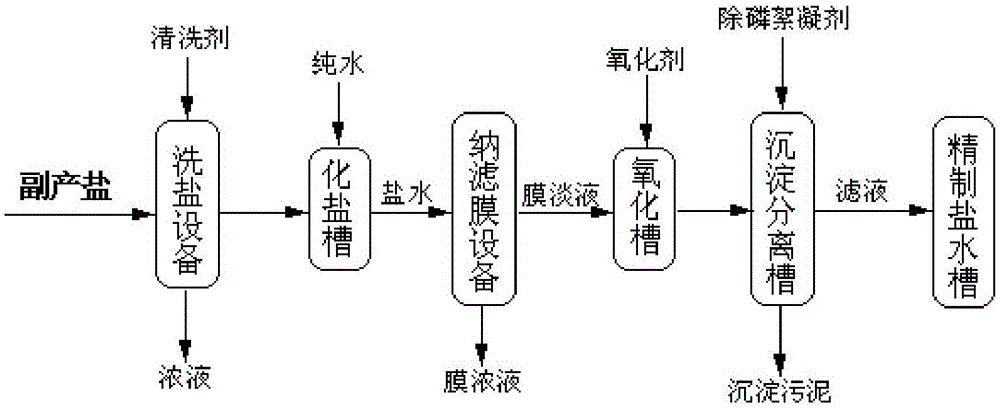Refining process method of by-product salt on production line of glyphosate
A process method, glyphosate technology, applied in the field of environmental protection, can solve the problems of waste of sodium chloride resources, high equipment requirements, high burning costs, etc., and achieve the effect of low processing cost, high economic and social benefits, and mild reaction conditions
- Summary
- Abstract
- Description
- Claims
- Application Information
AI Technical Summary
Problems solved by technology
Method used
Image
Examples
Embodiment 1
[0029] Get 5kg of by-product salt obtained on the glyphosate production route prepared by glycine method, clean with cleaning agent, control the mass ratio of cleaning agent consumption and solid salt to be 1:1, the cleaning time is 30min, and the number of times of cleaning is 1 time, and then Vacuum filtration was performed to obtain a solid salt. The solid salt was reconstituted into a solution with a NaCl content of 300g / L. The total organic carbon TOC measured was 158.6mg / L, the total nitrogen TN was 29.05mg / L, and the TP was 93.2mg / L.
[0030] Adjust the pH of the prepared brine to 10 with 1mol / L NaOH, and then conduct nanofiltration membrane separation, control the membrane inlet pressure at 2.0MPa, the temperature at 13.1±2°C, and the concentration ratio of the nanofiltration membrane is 5 times by mass When the nanofiltration membrane separation is stopped. The measured total organic carbon (TOC) of nanofiltration membrane weak liquid is 26.29mg / L, total nitrogen (TN...
Embodiment 2
[0033]Get 5kg of by-product salt obtained on the glyphosate production route prepared by glycine method, clean with cleaning agent, control the mass ratio of cleaning agent consumption and solid salt to 7:5, the cleaning time is 20min, and the number of times of cleaning is 1 time, and then Vacuum filtration was carried out, and the solid salt was obtained after vacuum drying. The solid salt was reconstituted into a solution with a NaCl content of 300g / L. The total organic carbon TOC was measured to be 301.45mg / L, the total nitrogen TN was 53.97mg / L, and the TP was 185mg / L.
[0034] Use 1mol / L NaOH to adjust the pH of the prepared brine to 10, and then perform nanofiltration membrane separation. Control the membrane inlet pressure at 2.6MPa, the temperature at 14.7±2°C, and the concentration ratio of the nanofiltration membrane is 5 times by mass. When the nanofiltration membrane separation is stopped. The measured total organic carbon (TOC) of nanofiltration membrane weak li...
Embodiment 3
[0037] Get 5kg of by-product salt obtained on the glyphosate production route prepared by glycine method, clean with cleaning agent, control the mass ratio of cleaning agent consumption and solid salt to 3:1, the cleaning time is 10min, and the number of times of cleaning is 1 time, and then Vacuum filtration was carried out, and the solid salt was obtained after vacuum drying. The solid salt was reconstituted into a solution with a NaCl content of 300g / L. The total organic carbon TOC was measured to be 301.45mg / L, the total nitrogen TN was 53.97mg / L, and the TP was 185mg / L.
[0038] Adjust the pH of the prepared brine to 10 with 1mol / L NaOH, and then conduct nanofiltration membrane separation, control the membrane inlet pressure at 2.6MPa, the temperature at 14.7±2°C, and the concentration factor of the nanofiltration membrane calculated as 5 times by mass Stop the nanofiltration membrane separation. The measured total organic carbon (TOC) of nanofiltration membrane weak liq...
PUM
 Login to View More
Login to View More Abstract
Description
Claims
Application Information
 Login to View More
Login to View More - R&D
- Intellectual Property
- Life Sciences
- Materials
- Tech Scout
- Unparalleled Data Quality
- Higher Quality Content
- 60% Fewer Hallucinations
Browse by: Latest US Patents, China's latest patents, Technical Efficacy Thesaurus, Application Domain, Technology Topic, Popular Technical Reports.
© 2025 PatSnap. All rights reserved.Legal|Privacy policy|Modern Slavery Act Transparency Statement|Sitemap|About US| Contact US: help@patsnap.com

